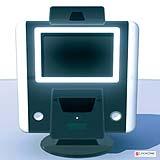 Jeff Thurston at Vector One notes that 3Dsolar was one of this year’s European IST prize winners for a 3D technology that floats an image in front of the screen. “There are numerous possibilities for this type of technology in the spatial information field,” writes Jeff.
Jeff Thurston at Vector One notes that 3Dsolar was one of this year’s European IST prize winners for a 3D technology that floats an image in front of the screen. “There are numerous possibilities for this type of technology in the spatial information field,” writes Jeff.
There are some intriguing clues that this might happen sooner rather than later:
- Somebody affiliated with 3Dsolar (founder and inventor Patrick Levy Rosenthal?) was an early contributor of a network link that remains one of the most useful around. So the company is well aware of Google Earth as a 3D visualisation tool.
- Ex-Keyhole CEO John Hanke’s inspiration for Google Earth, the CIC Earth in Neal Stephenson’s 1992 novel Snow Crash, is a true floating 3D marvel. Time perhaps for an excerpt from the book?
There is something new: A globe about the size of a grapefruit, a perfectly detailed rendition of Planet Earth, hanging in space at arm’s length in front of his eyes. Hiro has heard about this but never seen it. It is a piece of CIC software called, simply, Earth. It is the user interface that CIC uses to keep track of every bit of spatial information that it owns – all the maps, weather data, architectural plans, and satellite surveillance stuff. (Ch. 13)
Earth materializes, rotating majestically in front of his face. Hiro reaches out and grabs it. He twists it around so he’s looking at Oregon. (Ch. 35)
3Dsolar’s technology allows you to grab 3D floating objects like that. From their website:
The 3Dsolar screen projects a virtual image that can be physically manipulated with the user’s hands as if it were a real object. 3Dsolar screens in retail store windows will offer the opportunity for passer-byes to interact with the virtual products projected outside of the store’s window.
- For those of you with a programming bent, 3Dsolar now has an SDK out for their technology:
The SDK is free of charge and allows CAD designers, animation creators, developers, and content providers to view and present their work on 3Dsolar display screens.
As details about the technology are hard to come by, this may offer some clues. I’m awaiting my download link as I blog this.
When the units go into production mid-2006 (according to the company’s forum), they’ll cost around $6,000 each, falling to $3,000 as production ramps up (according to the press release). At that price point, Google should be able to afford a few for demonstration purposes:-)
Celestia is in fact more appropriated to 3Dsolar screens, we have very big textures in DDS for the Earth and Mars (Thanks to Nasa and alot of work to tile everything together) so the result is very good and you can rotate left, right, up, or down around the globe, 3Dsolar amplify the rotation of the globe so with 30º of physical rotation you can rotate the globe (earth mars or what ever you want) by 180º
So far the feeling is that half part of the globe is outside the screen, but we are able to push it completely out reducing the angle of view (less confortable).
We are also working on customs maps for new GPS phones like hw 6915 (HP) the project name is “ShotMap”, it will show you in realtime on a google map and draw your traject and calculate your distance. many other interesting features will be included.
See you soon..